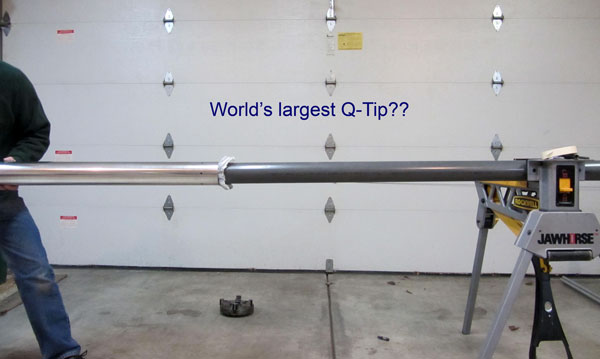I took a few pictures of the work in progress for THRP-1 (Tiny Hybrid Rocket Project 1) motor.
The coupler is nearing completion. The combustion chamber side is essentially machined though I may lighten it a bit more. The tank side does not have the holes yet for the bolt pins. The coupler also does not have the retention bolt holes for the injector assembly. The injector assembly slides in from the tank side of the coupler and butts up against the internal hard stop. It will have its own O-rings.
I left the O-rings off the tank side of the coupler. Each side has 3 O-rings. The two towards each end are gas check. The ones towards the middle of the coupler are for taking up slack and vibration absorption. I haven't done it yet but there will be a pinhole through the tank tube and combustion chamber tubes for pressure release just in case gasses get in there.
In the combustion chamber side of the coupler, the black tube stuck in the end is a section of 54mm phenolic liner being used as precombustion chamber thermal insulation. Retention is by the 4 bolts and washers on the end of the coupler. These should be considered sacrificial each burn as they will probably end up rather corroded.
I forgot to bring the nozzle over or I would have shown it. That part is done. It is a pretty conventional graphite nozzle; nothing special it's just shorter than average with a throat and convergent section machined better than most commercial nozzles. Note to those who don't know - a long throat in a nozzle costs perhaps 10% total ISP. Most commercial nozzles have long throats...
I didn't bring the tank tube. Right now it is just a squared off length of 6061-T6 DOM seamless tubing. It's perhaps 2 1/2 times the length of the combustion chamber. For scale, the motor is 76mm and somewhere around 5' long, and will be an M.
I'll provide more pictures later when I have something more to show. Since I'm manually machining everything and often with what is not really the appropriate tools, it goes a little slowly. It doesn't help that the bolts I have are a little long and need to be ground down - there are a lot of them!
Yes there are more bolt pins than really needed, particularly because this is a low pressure hybrid design via valve regulated tank pressure. But the design is for a minimum diameter rocket. The motor is the body. The coupler therefore needs maximum stability. Clearance on insertion is about 0.0015" and the O-rings are under some compression - a bit more than usual usage. The multitude of pins provide some additional stability. Besides, changing out the injector assembly, the nozzle, and the upper bulkhead with its valve allows me to choose different operationg pressures and mass flow so there is a lot of flexability for burn profiles. If I up the operating flight tank pressure (which drops ISP for N2O hybrids) then the pins are a little more appropriate in count.
My plan was to complete the motor this week but that might not happen. The horizontal bandsaw decided to quit working halfway thruogh a 3" aluminum bar which was going to be the upper bulkhead. Rather than fix the bandsaw at the moment, I ordered some more metal already cut to length. But it might not be here this week.



Gerald











